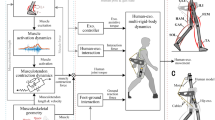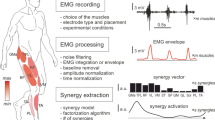Studies of motor control in humans require the formation of adequate concepts about the structure and metric characteristics of the musculoskeletal system, which provides the performance of the respective movements; such representations, in turn, are necessary prerequisites for further modeling of the phenomenology of motor control, theoretical analysis of the relevant processes, and interpretation of the obtained experimental data. We measured the length and shape of the muscles of the shoulder girdle (deltoideus pars scapilaris and pectoralis major pars clavicularis) of a healthy person performing planar (realized within the horizontal plane) movements of the upper limb, in which the hand moved via a straight line in the parafrontal plane at the level of the shoulder joint, and also calculated the corresponding arms of torques developed by these muscles. Such measurements were performed based on the results of computed tomography and 3D prints of the bones (scapula, clavicula, and humerus). According to these data, we built regression formulas for the dependence of metric parameters of the muscles on values of the angle in the shoulder joint. The results of modeling of descending activation of these muscles during the mentioned movements are also presented; EMG signals recorded from the corresponding muscles were considered correlates of the descending commands. The results of such simulation demonstrated a satisfactory similarity between the characteristics of the modeled motor commands and those recorded in real experiments. The results obtained show that we have developed a realistic model of the musculoskeletal system of the upper extremity, which can be effectively used in studies of motor control in humans. Moreover, there are reasons to believe that our proposed method of estimating the parameters of the musculoskeletal system of the human arm is significantly more adequate than those previously proposed, in which the original data underwent excessive simplification.
Similar content being viewed by others
References
M. Dornowski, Ye. V. Kolosova, and A. V. Gorkovenko, “Gender and age-related peculiarities of the H-reflex indices in sportsmen,” Neurophysiology, 49, No. 6, 458–461 (2017). doi: https://doi.org/10.1007/s11062-018-9709-3
M. Dornowski, V. S. Mishchenko, and A. V. Gorkovenko, “Functional connections in the human cerebral cortex at repetitive flexions and extensions of the fingers,” Neurophysiology, 50, No. 4, 286–291 (2018). doi: https://doi.org/10.1007/s11062-018-9750-2
M. Dornowski, A. Gorkovenko, T. Tomiak, et al. “Cyclic movement execution and its influence on motor programmes,” Ann. Agric. Environ. Med., 26, No. 2, 361–368 (2019). doi: https://doi.org/10.26444/aaem/94881
А. I. Kostyukov, O. V. Lehedza, A. V. Gorkovenko, et al., “Hysteresis and synergy of the central commands to muscles participating in parafrontal upper limb movements,” Front. Physiol., 10, 1441 (2019). doi: https://doi.org/10.3389/fphys.2019.01441
A. I. Kostyukov, “Theoretical analysis of the force and position synergies in two-joint movements,” Neurophysiology, 48, No. 4, 287–296 (2016). doi: https://doi.org/10.1007/s11062-016-9601-y
A. I. Kostyukov and T. Tomiak, “The force generation in a two-joint arm model: analysis of the joint torques in the working space,” Front. Neurorobotics, 12, 77 (2018). doi: https://doi.org/10.3389/fnbot.2018.00077
A. V. Gorkovenko, “Theoretical analysis of the peculiarities of motor control at generation of two-joint isometric efforts by the human upper limb,” Neurophysiology, 50, No. 4, 309–321 (2018). doi: https://doi.org/10.1007/s11062-018-9753-z
A. V. Gorkovenko, T. Tomiak, W. Pilewska, and A. I. Kostyukov, “Synergetic control during generation of a maximal isometric effort by the human arm,” Neurophysiology, 52, No. 1, 49–59 (2020). doi: https://doi.org/10.1007/s11062-020-09850-9
V. Gritsenko, R. L. Hardesty, M. T. Boots, and S. Yakovenko, “Biomechanical constraints underlying motor primitives derived from the musculoskeletal anatomy of the human arm,” PLoS One, 11, e0164050 (2016). doi: https://doi.org/10.1371/journal.pone.0164050
M. Asghari, S. Behzadipour, and G. Taghizadeh, “A planar neuro-musculoskeletal arm model in post-stroke patients,” Biol. Cybern., 112, 483–494 (2018). doi: https://doi.org/10.1007/s00422-018-0773-y
J. Zhou, N. C. Benson, K. Kay, and J. Winawer, “Predicting neuronal dynamics with a delayed gain control model,” PLoS Comput. Biol., 15, e1007484 (2019). doi: https://doi.org/10.1371/journal.pcbi.1007484
P. Pigeon, L. Yahia, and A. G. Feldman, “Moment arms and lengths of human upper limb muscles as functions of joint angles,” J. Biomech., 29, No. 10, 1365–1370 (1996). doi: https://doi.org/10.1016/0021-9290(96)00031-0
B. A. Garner and M. G. Pandy, “The obstacle-set method for representing muscle paths in musculoskeletal models,” Comput. Methods Biomech. Biomed. Engin., 3, 1–30 (2000). doi: https://doi.org/10.1080/10255840008915251
S. L. Delp, F. C. Anderson, A. S. Arnold, et al., “OpenSim: open-source software to create and analyze dynamic simulations of movement,” IEEE Trans. Biomed. Eng., 54, 1940–1950 (2007). doi: https://doi.org/10.1109/TBME.2007.901024
I. V. Vereshchaka, A. V. Gorkovenko, O. V. Lehedza, et al., “EMG patterns of the elbow- and shoulderoperating muscles in slow parafrontal upper limb movements under isotonic loading,” Neurophysiology, 50, No. 6, 466–474 (2018). doi: https://doi.org/10.1007/s11062-019-09779-8
А. V. Gorkovenko, O. V. Lehedza, T. I. Abramovych, et al., “Evaluation of the complexity of control of simple linear hand movements using principal component analysis,” Neurophysiology, 51, No. 2, 132–140 (2019).
M. Winters, “Hill-based muscle models: a systems engineering perspective,” in: J. M. Winters and S. L. Y. Woo (eds.), Multiple Muscle Systems, Springer, New York, pp. 69–93 (1990).
T. S. Buchanan, D. G. Lloyd, K. Manal, and T. F. Besier, “Estimation of muscle forces and joint moments using a forward-inverse dynamics model,” Med. Sci. Sports Exerc., 37, 1911–1916 (2005). doi: https://doi.org/10.1249/01.mss.0000176684.24008.6f
T. Siebert, N. Stutzig, and C. Rode, “A Hill-type muscle model expansion accounting for effects of varying transverse muscle load,” J. Biomech., 66, 57–62 (2018). doi: https://doi.org/10.1016/j.jbiomech.2017.10.043
D. Stanev and K. Moustakas, “Stiffness modulation of redundant musculoskeletal systems,” J. Biomech., 85, 101–107 (2019). doi: https://doi.org/10.1016/j.jbiomech.2019.01.017
А. Seth, M. Dong, R. Matias, and S. Delp, “Muscle contributions to upper-extremity movement and work from a musculoskeletal model of the human shoulder,” Front. Neurorobot., 13, 90 (2019). doi: https://doi.org/10.3389/fnbot.2019.00090
D. Buongiorno, M. Barsotti, F. Barone, et al., “A linear approach to optimize an EMG-driven neuromusculoskeletal model for movement intention detection in myo-control: a case study on shoulder and elbow joints,” Front. Neurorobot., 12, 74 (2018). doi: https://doi.org/10.3389/fnbot.2018.00074
F. Hik and D. C. Ackland, “The moment arms of the muscles spanning the glenohumeral joint: a systematic review,” J. Anat., 234, No. 1, 1–15 (2019). doi: https://doi.org/10.1111/joa.12903
A. Garner and M. G. Pandy, “Musculoskeletal model of the upper limb based on the visible human male dataset,” Comput. Methods Biomech. Biomed. Eng., 4, No. 2, 93–126 (2001). doi: https://doi.org/10.1080/10255840008908000
B. K. Kuechle, S. R. Newman, E. Itoi, et al., “Shoulder muscle moment arms during horizontal flexion and elevation,” J. Shoulder Elbow Surg., 6, No. 5, 429–439 (1997). doi: https://doi.org/10.1016/s1058-2746(97)70049-1
P. L. Cheng, “Simulation of Codman’s paradox reveals a general law of motion,” J Biomech, 39, No. 7, 1201–1207 (2006). doi: https://doi.org/10.1016/j.jbiomech.2005.03.017
S. I. Wolf, L. Fradet, and O. Rettig, “Conjunct rotation: Codman’s paradox revisited,” Med. Biol. Eng. Comput., 47, No. 5, 551–556 (2009). doi: https://doi.org/10.1007/s11517-009-0484-6
E. Pennestri, R. Stefanelli, P. P. Valentini, and L. Vita, “Virtual musculo-skeletal model for the biomechanical analysis of the upper limb,” J. Biomech., 40, 1350–1361 (2007). doi: https://doi.org/10.1016/j.jbiomech.2006.05.013
M. Hayashibe and D. Guiraud, “Voluntary EMG-toforce estimation with a multi-scale physiological muscle model,” Biomed. Eng. Online, 12, 86 (2013). doi: https://doi.org/10.1186/1475-925X-12-86
A. Falisse, S. V. Rossom, I. Jonkers, and F. D. Groote, “EMG-driven optimal estimation of subject-specific Hill model muscle-tendon parameters of the knee joint actuators,” IEEE Trans. Biomed. Eng., 64, No. 9, 2253–2262 (2017). doi: https://doi.org/10.1109/TBME.2016.2630009
W. Herzog, “Passive force enhancement in striated muscle,” J. Appl. Physiol. (1985), 126, No. 6, 1782–1789 (2019). doi: https://doi.org/10.1152/japplphysiol.00676.2018
R. A. M. Pinnell, P. Mashouri, N. Mazara, et al., “Residual force enhancement and force depression in human single muscle fibres,” J. Biomech., 91, 164–169 (2019). doi: https://doi.org/10.1016/j.jbiomech.2019.05.025
A. I. Kostyukov, “Muscle hysteresis and movement control: a theoretical study,” Neuroscience, 83, No. 1, 303–320 (1998). doi: https://doi.org/10.1016/s0306-4522(97)00379-5.
A. I. Kostyukov, F. Hellstrom, O. E. Korchak, et al., “Fatigue effects in the cat gastrocnemius during frequency-modulated efferent stimulation,” Neuroscience, 97, No. 4, 789–799 (2000). doi: https://doi.org/10.1016/s0306-4522(00)00066-x
A. P. Mel’nichouk, N. V. Bulgakova, A. N. Tal’nov, et al., “Movement-dependent positioning errors in human elbow joint movements,” Exp. Brain Res., 176, No. 2, 237–247 (2007). doi: https://doi.org/10.1007/s00221-006-0612-6
A. V. Gorkovenko, O. V. Legedza, I. V. Vereschaka, et al., “Erratum to: Hysteresis properties of EMG activity of the shoulder belt and shoulder muscles at the development of isometric efforts by the human arm,” Neurophysiology, 47, No. 2. doi: https://doi.org/10.1007/s11062-015-9516-z
Author information
Authors and Affiliations
Corresponding author
Rights and permissions
About this article
Cite this article
Gorkovenko, A.V., Strafun, S.S., Kulyk, Y.A. et al. Motor Commands for Planar Movements of the Upper Limb: Modeling with Taking into Account Realistic Osteo-Muscular Relations. Neurophysiology 52, 222–233 (2020). https://doi.org/10.1007/s11062-020-09874-1
Received:
Published:
Issue Date:
DOI: https://doi.org/10.1007/s11062-020-09874-1




